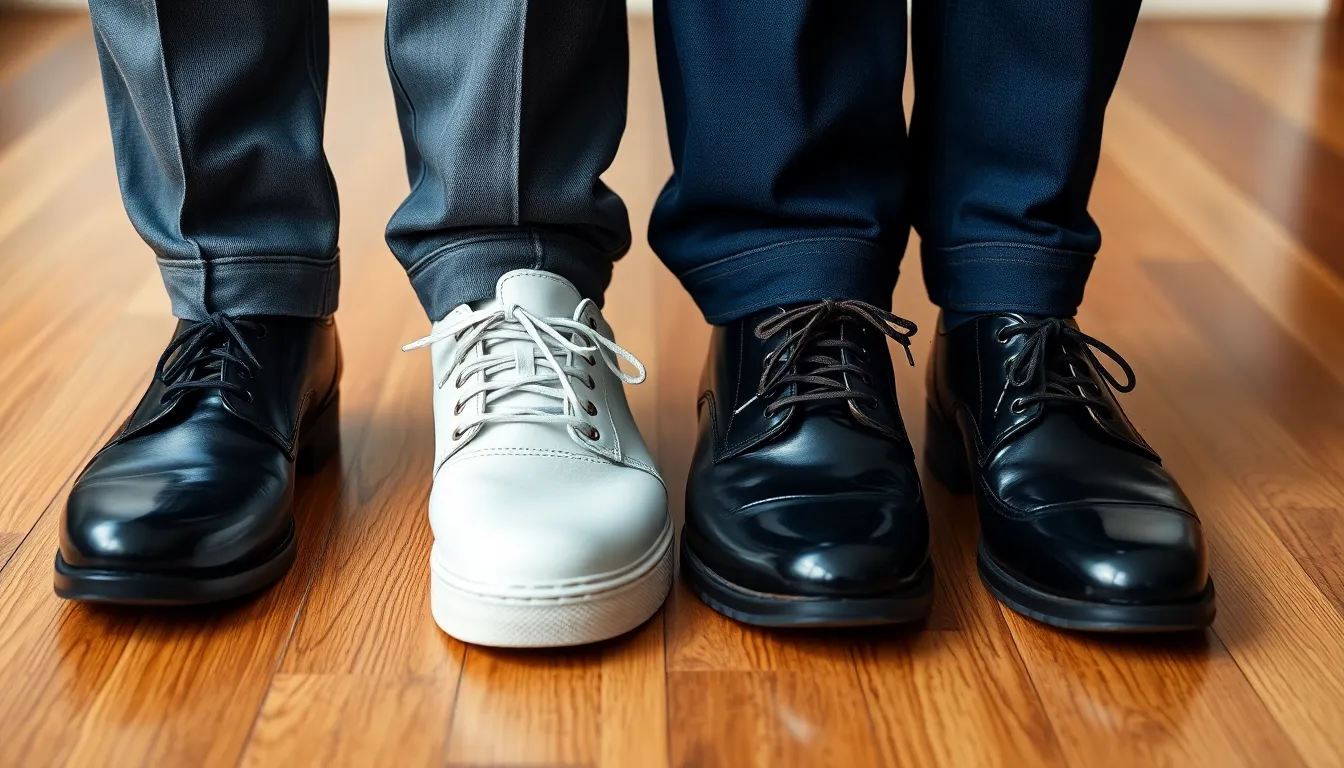Table of Contents
ToggleEver found yourself staring at a shoe rack, wondering what a men’s size 8 translates to in women’s? You’re not alone! The world of shoe sizing can feel like a secret code designed to keep you guessing. But fear not, because understanding this conversion is easier than you might think.
Understanding Shoe Size Conversions
Shoe size conversions can confuse many buyers, particularly when switching between men’s and women’s sizes. However, grasping these conversions simplifies the shopping experience.
The Basics of Shoe Sizing
Shoe sizes differ between genders due to variations in foot shape and width. Generally, a men’s size is approximately 1.5 to 2 sizes smaller than a women’s size. For example, a men’s 8 translates to a women’s 9.5 or 10. Knowing these basic rules allows for easier navigation when purchasing shoes.
Importance of Accurate Sizing
Choosing the correct shoe size impacts comfort and style. Ill-fitting shoes can lead to discomfort, blisters, or long-term foot issues. Accurate sizing enhances the overall experience. Buyers can enjoy shoes that not only fit well but also complement their style. Understanding shoe size conversions plays a crucial role in making informed decisions during purchases.
What Is a Men’s 8 in Womens?

Shoe sizing varies between men and women, which often leads to confusion. A men’s size 8 typically corresponds to a women’s size 9.5 or 10. Understanding this conversion helps shoppers select the right fit for comfort and style.
The Conversion Formula
To convert men’s sizes to women’s sizes, add 1.5 to 2 sizes. A common formula suggests that if someone wears a size 8 in men’s shoes, they might need a 9.5 or 10 in women’s. This difference arises from variations in foot shape and width, making the conversion crucial for accurate fitting.
Examples of Size Comparisons
Many examples illustrate this sizing difference. For instance, if someone wears a men’s 7, the equivalent in women’s would be between 8.5 and 9. Similarly, a men’s 9 translates to a women’s 10.5 or 11. Recognizing these conversions ensures that shoppers find shoes that fit properly, enhancing overall comfort.
Factors Affecting Fit
Shoe fit can vary significantly based on several key factors. Understanding these factors helps ensure proper sizing and comfort.
Brand Variability
Different brands often use unique sizing charts, leading to inconsistencies in fit. Some brands may design shoes with a wider toe box, while others focus on a narrow fit. Variations in construction materials can also impact how a shoe fits, as softer materials conform more readily to foot shape. Each shoe brand has unique sizing practices, so checking individual charts is essential. Relying solely on standard size conversions may lead to discomfort or sizing issues. Investing time in researching brand-specific sizes enhances the likelihood of finding the perfect pair.
Style Differences
The style of the shoe significantly influences fit. Sneakers typically offer more room and flexibility compared to formal shoes, which tend to have a tighter fit. Heels can change overall foot positioning, affecting how a shoe feels when worn. Various styles, such as boots versus sandals, can also vary in width and arch support. Each design has unique characteristics specific to its function and look. Trying on different styles before purchasing assures better comfort and fit. Recognizing these distinctions helps in selecting shoes that not only fit but also cater to personal style preferences.
Tips for Buying Shoes
Finding the right fit is essential for comfort. Proper sizing can prevent foot issues down the line.
Trying on Shoes
Trying on shoes before buying provides invaluable insight into fit and comfort. Evaluate the shoe by walking around in it, ensuring ample support and cushioning. Focus on the toe box; there should be enough room for toes to wiggle and move. Pay attention to arch support as it plays a significant role in overall comfort. When shopping, it’s advisable to try shoes at the end of the day since feet tend to swell slightly. Trying on various styles will also help identify what works best for individual foot shapes.
Online Size Charts
Online size charts offer a helpful reference when shopping for shoes. Most brands provide specific conversion charts that indicate the equivalent size across genders. It’s crucial to check the brand’s website for accurate sizing, as discrepancies can arise. Measuring the foot length in inches or centimeters can also assist in choosing the right size. Keep in mind that customer reviews often include insights on fit, helping gauge whether to size up or down. Relying on these charts can lead to informed decisions, minimizing the risk of ordering the wrong size.
Navigating shoe sizes can be tricky but understanding the conversion from men’s to women’s sizes is essential for finding the perfect fit. A men’s size 8 typically corresponds to a women’s size 9.5 or 10. This knowledge not only enhances comfort but also ensures style choices align with personal preferences.
Being aware of factors like brand variability and shoe style can further refine the shopping experience. Trying on shoes and considering foot measurements can make all the difference in achieving a comfortable fit. With the right information and a little diligence, anyone can confidently choose shoes that feel great and look stylish.







